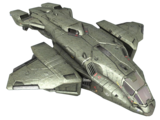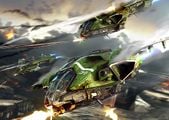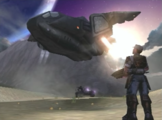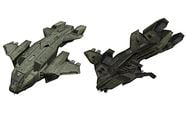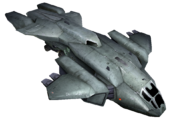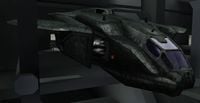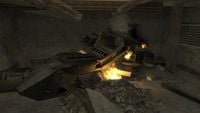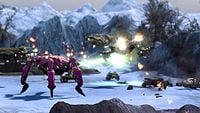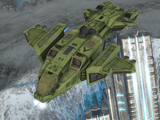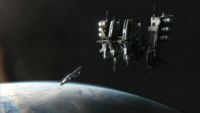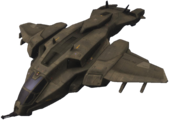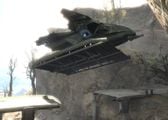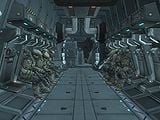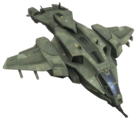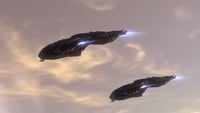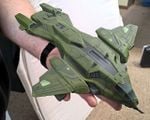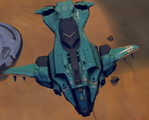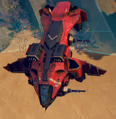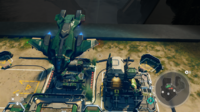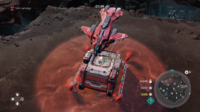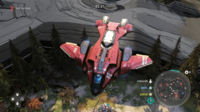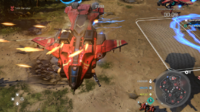D77-TC Pelican: Difference between revisions
From Halopedia, the Halo wiki
mNo edit summary |
No edit summary |
||
| Line 5: | Line 5: | ||
|image=[[File:H2AD77.jpg|350px]] | |image=[[File:H2AD77.jpg|350px]] | ||
|name=Dropship 77-Troop Carrier | |name=Dropship 77-Troop Carrier | ||
|manufacturer= [[Misriah Armory]]<ref>'''[[Halo: Arms Race]]'''</ref> | |manufacturer=[[Misriah Armory]]<ref>'''[[Halo: Arms Race]]'''</ref> | ||
|line=Pelican | |line=Pelican | ||
|class=Pelican Dropship 77-Troop Carrier | |class=Pelican Dropship 77-Troop Carrier | ||
| Line 15: | Line 15: | ||
|max speed space= | |max speed space= | ||
|max speed air= | |max speed air= | ||
|engine=* | |engine=*Four [[Fusion drive|hybrid fusion drives]] {{C|two primary, two secondary}}<ref name="Warfleet"/> | ||
*Gravitic assist generator<ref name="Warfleet"/> | *Gravitic assist generator<ref name="Warfleet"/> | ||
|slipspace drive=No | |slipspace drive=No | ||
| Line 24: | Line 23: | ||
|shield gen=Heat and radiation shielding to protect occupants. | |shield gen=Heat and radiation shielding to protect occupants. | ||
|hull= | |hull= | ||
|sensors= | |sensors=[[RADAR]]/LIDAR detectors<ref name="Warfleet"/> | ||
|target= | |target= | ||
|navigation=Motion trackers<ref>'''Halo: Combat Evolved''', campaign level ''[[343 Guilty Spark (level)|343 Guilty Spark]]''</ref> | |navigation=Motion trackers<ref>'''Halo: Combat Evolved''', campaign level ''[[343 Guilty Spark (level)|343 Guilty Spark]]''</ref> | ||
|avionics= | |avionics= | ||
|armament=Single or twin-linked nose-mounted projectile weapons: [[M370 autocannon]] {{C|standard}},<ref name="EVG">'''[[Halo: The Essential Visual Guide]]''', ''page 135''</ref><ref name="The Flood">'''Halo: The Flood''', ''page 39''</ref> [[40mm chain gun]],<ref name="TFoR">'''Halo: The Fall of Reach''', ''page 92'' (''"John sized up her armaments - dented and charred armor, a pair of old, out-of-date 40mm chain guns."'')</ref> large-caliber rotary machine gun<ref name="Halo 2">''Halo 2''</ref> | |||
|armament=Single or twin-linked nose-mounted projectile weapons: [[M370 autocannon]] | |||
*Two [[ANVIL-II Air-to-Surface Missile]] pods (eight missiles each) {{C|optional}} | *Two [[ANVIL-II Air-to-Surface Missile]] pods (eight missiles each) {{C|optional}} | ||
*One [[AIE-486H Heavy Machine Gun]] | *One optional aft-facing turret: | ||
* | **[[AIE-486H Heavy Machine Gun]] | ||
* | **[[M247 General Purpose Machine Gun]] | ||
* | **[[M460 Automatic Grenade Launcher]]<ref name="Warfleet"/> or | ||
**[[M68 Gauss cannon]]<ref name="Warfleet"/> | |||
|complement=10-20 passengers; in addition to: | |complement=10-20 passengers; in addition to: | ||
*One [[M808 Main Battle Tank|M808 main battle tank]] or | *One [[M808 Main Battle Tank|M808 main battle tank]] or | ||
| Line 46: | Line 40: | ||
*One [[troop deployment pod]] or | *One [[troop deployment pod]] or | ||
*One [[deployable bridge]]<ref>'''Halo: Reach''', campaign level ''[[Tip of the Spear]]''</ref> | *One [[deployable bridge]]<ref>'''Halo: Reach''', campaign level ''[[Tip of the Spear]]''</ref> | ||
*70 tons of cargo on hoist, | *70 tons of cargo on hoist, {{C|anything over 35 tons slows speed considerably.}} | ||
|crew=*One [[pilot]] | |crew=*One [[pilot]] | ||
*One co-pilot | *One co-pilot | ||
| Line 68: | Line 62: | ||
==Design== | ==Design== | ||
=== | ===Crew and Complement=== | ||
The | The pelican is crewed by two personnel who occupy the tantem cockpit at the front of the dropship. The [[pilot]] sits on the right side, with the electronics operator or gunner taking up the station on the left. All flight controls are a digital fly-by-light with no manual backups; an integral expert system optimizes stability and adjusts the thruster profiles under all regimes and cargo profiles. Unlike on the later [[D79-TC pelican]], the cockpit is only accessible from the cargo-bay. Motion trackers, [[RADAR]]/LIDAR sensors and a computerized mapping system allow the pilot to plan their way to nearby staging areas as well as to warn of incoming threats.<ref name="Warfleet"/> | ||
The cargo-bay, colloquially dubbed by Marines as the "blood tray", usually accommodates up to ten personnel in jumpseats, with a small overhead compartment for their weapons and equipment. Additional infantry can be carried standing up, and increased seating for ten more people can be installed in the center aisle. Otherwise, this space can be used to carry cargo pallets, casualty litters, or even small utility vehicles such as two [[M274 Mongoose|M274 mongeese ULATV]].<ref name="Warfleet"/> The Pelican is also equipped with an onboard weapons locker, which can hold enough weapons and ammunition to arm thirty troopers.<ref name="secrets"/>. At least one pelican has been modified to act as a boarding craft for [[Operation: RED FLAG]], which has enough room to ferry twenty-five [[SPARTAN-II program|SPARTAN-IIs]] to their target, as well as carry the cutting gear needed to cut through the hull of a Covenant warship. | |||
The large aft overhang | The large aft overhang provides a magnetic and physical attachment point for additional cargo and ordnance. Possible payloads include a [[troop deployment pod]], an [[M808B Main Battle Tank]], an [[M12 Force Application Vehicle]], or eight [[resupply canister]]s. It is discouraged for pilots to transport objects in the clamp during orbital insertions, as it can complicate reentry.<ref name="Warfleet"/> | ||
===Armament=== | ===Armament=== | ||
The Pelican's primary armament consists of one or more nose-mounted projectile weapons, typically autocannons or machine guns. Commonly known as "chin guns" due to their placement,<ref name="EVG"/> these weapons are controlled via an Integrated Helmet and Display Sight System (IHADSS), which links to the pilot's or co-pilot's [[heads-up display]] and allows them to target the gun by head movements.<ref name="secrets"/><ref>'''Halo: the Flood''', ''page 77''</ref> The Pelican's standard armament is a chin-mounted [[M370 autocannon]], which is sometimes linked with another such weapon;<ref>'''Halo: Ghosts of Onyx''', ''page 40''</ref> the M370 | The Pelican's primary armament consists of one or more nose-mounted projectile weapons, typically autocannons or machine guns. Commonly known as "chin guns" due to their placement,<ref name="EVG"/> these weapons are controlled via an Integrated Helmet and Display Sight System (IHADSS), which links to the pilot's or co-pilot's [[heads-up display]] and allows them to target the gun by head movements.<ref name="secrets"/><ref>'''Halo: the Flood''', ''page 77''</ref> The Pelican's standard armament is a chin-mounted [[M370 autocannon]], which is sometimes linked with another such weapon;<ref>'''Halo: Ghosts of Onyx''', ''page 40''</ref> the M370 fires 70mm high-explosive armor-piercing (HEAP) rounds as standard ammunition, with depleted-Uranium slugs also being an option. This replaced the older [[40mm chain gun]] that was common prior to [[2525]].<ref name="TFoR"/> Some Marine Corps Pelicans are armed with a single a rotary machine gun instead of a chain gun.<ref name="Halo 2"/> | ||
In addition to its primary armament, the Pelican | In addition to its primary armament, the Pelican has four externally-mounted missile hardpoints, which typically hold eight [[ANVIL-II Air-to-Surface Missile]]s. However, they can carry a variety of weapon systems or specialized equipment pods. A turret can be placed at the back of the cargo-bay to provide covering fire when not in use, and can range from [[M247 General Purpose Machine Gun|machine guns]], to [[M460 Automatic Grenade Launcher|grenade launchers]], and even a [[M68 Gauss cannon|gauss cannon]].<ref name="Warfleet"/> While some weapons can be folded against the roof when not in use, others such as the [[AIE-486H Heavy Machine Gun]] can not. | ||
===Propulsion=== | ===Propulsion=== | ||
The main engines | Pelicans utilize a complicated propulsion system that combines vectored-thrust fusion ram-rockets with air-breathing hyperfans, divided between two primary and two secondary articulated engine pods. While ideal for use in an atmospheric environment, they require a [[Hydrogen]] reaction mass in order to operate.<ref name="Warfleet"/> The two main engines have four nacelles each, two on the bottom and two at the back. The aft engines being similar but lack a nacelle at the bottom. Because both modules are mounted on rotating blocks, they can redirect themselves from directing the thrust downwards to any direction required. Although fully capable of orbital transit, the D77 is too small to be equipped with a [[Shaw-Fujikawa Translight Engine]], and is thus incapable of slipspace travel.{{citation needed}} | ||
===Countermeasures=== | |||
The D77-TC pelican, like most other UNSC aerospace vehicles, is fitted with a suite of countermeasures to warn the dropship of incoming attacks, break target locks, and mitigate the effects of electronic warfare. These include wide-spectrum flares, microdrone decoys, rainbow laser blinders, [[RADAR]]/LIDAR sensors, directional jammers, and "hard chop" guillotines on data processing modules that could be susceptible to cyber-intrusion agents.<ref name="Warfleet"/> To prevent them from being easily taken out by [[electromagnetic pulse]]s, the pelican's electronic systems are hardened against such phenomena. | |||
=== | |countermeasures=*Wide-spectrum flares<ref name="Warfleet"/> | ||
*Microdrone decoys<ref name="Warfleet"/> | |||
*Rainbow laser blinders<ref name="Warfleet"/> | |||
*RADAR/LIDAR detectors<ref name="Warfleet"/> | |||
*Directional jammers<ref name="Warfleet"/> | |||
*"Hard-chop" guillotines on data processing modules<ref name="Warfleet"/> | |||
==Variants== | ==Variants== | ||
Revision as of 12:38, May 5, 2018
| This article does not have enough inline citations and/or does not adhere to the proper citation format. You can help Halopedia by adding citations. |
The D77-TC Pelican, formally known as the Dropship 77-Troop Carrier and commonly known as the Pelican, is an extremely versatile space-to-ground capable craft used by the United Nations Space Command, mainly for the pickup and transportation of personnel, vehicles and equipment, as well as a powerful gunship.
The D77-TC Pelican is mainly responsible for the rapid insertion and extraction of troops, vehicles, and equipment to the battlefield. The D77-TC has been in service for over fifty years, and is the primary tactical support aircraft of the UNSC. The Pelican serves a multi-role purpose; it is fully capable of atmospheric flight and can land almost anywhere without difficulty. The Pelican is also capable of limited spaceflight, which the UNSC uses as a primary way of delivering troops to the surface from orbit. The UNSC also uses Pelicans as civilian vehicles for quick evacuations.[1][2]
The Pelican's standard armament consists of one Class III externally powered projectile weapon at the fore of the vehicle, and one Class I gas-operated projectile weapon mounted at the rear, in the extended crew area. More heavily armed variants exist, and the Pelican can be converted to a gunship role with the addition of numerous and more powerful weaponry.[3]
Design
Crew and Complement
The pelican is crewed by two personnel who occupy the tantem cockpit at the front of the dropship. The pilot sits on the right side, with the electronics operator or gunner taking up the station on the left. All flight controls are a digital fly-by-light with no manual backups; an integral expert system optimizes stability and adjusts the thruster profiles under all regimes and cargo profiles. Unlike on the later D79-TC pelican, the cockpit is only accessible from the cargo-bay. Motion trackers, RADAR/LIDAR sensors and a computerized mapping system allow the pilot to plan their way to nearby staging areas as well as to warn of incoming threats.[4]
The cargo-bay, colloquially dubbed by Marines as the "blood tray", usually accommodates up to ten personnel in jumpseats, with a small overhead compartment for their weapons and equipment. Additional infantry can be carried standing up, and increased seating for ten more people can be installed in the center aisle. Otherwise, this space can be used to carry cargo pallets, casualty litters, or even small utility vehicles such as two M274 mongeese ULATV.[4] The Pelican is also equipped with an onboard weapons locker, which can hold enough weapons and ammunition to arm thirty troopers.[5]. At least one pelican has been modified to act as a boarding craft for Operation: RED FLAG, which has enough room to ferry twenty-five SPARTAN-IIs to their target, as well as carry the cutting gear needed to cut through the hull of a Covenant warship.
The large aft overhang provides a magnetic and physical attachment point for additional cargo and ordnance. Possible payloads include a troop deployment pod, an M808B Main Battle Tank, an M12 Force Application Vehicle, or eight resupply canisters. It is discouraged for pilots to transport objects in the clamp during orbital insertions, as it can complicate reentry.[4]
Armament
The Pelican's primary armament consists of one or more nose-mounted projectile weapons, typically autocannons or machine guns. Commonly known as "chin guns" due to their placement,[6] these weapons are controlled via an Integrated Helmet and Display Sight System (IHADSS), which links to the pilot's or co-pilot's heads-up display and allows them to target the gun by head movements.[5][7] The Pelican's standard armament is a chin-mounted M370 autocannon, which is sometimes linked with another such weapon;[8] the M370 fires 70mm high-explosive armor-piercing (HEAP) rounds as standard ammunition, with depleted-Uranium slugs also being an option. This replaced the older 40mm chain gun that was common prior to 2525.[9] Some Marine Corps Pelicans are armed with a single a rotary machine gun instead of a chain gun.[10]
In addition to its primary armament, the Pelican has four externally-mounted missile hardpoints, which typically hold eight ANVIL-II Air-to-Surface Missiles. However, they can carry a variety of weapon systems or specialized equipment pods. A turret can be placed at the back of the cargo-bay to provide covering fire when not in use, and can range from machine guns, to grenade launchers, and even a gauss cannon.[4] While some weapons can be folded against the roof when not in use, others such as the AIE-486H Heavy Machine Gun can not.
Propulsion
Pelicans utilize a complicated propulsion system that combines vectored-thrust fusion ram-rockets with air-breathing hyperfans, divided between two primary and two secondary articulated engine pods. While ideal for use in an atmospheric environment, they require a Hydrogen reaction mass in order to operate.[4] The two main engines have four nacelles each, two on the bottom and two at the back. The aft engines being similar but lack a nacelle at the bottom. Because both modules are mounted on rotating blocks, they can redirect themselves from directing the thrust downwards to any direction required. Although fully capable of orbital transit, the D77 is too small to be equipped with a Shaw-Fujikawa Translight Engine, and is thus incapable of slipspace travel.[citation needed]
Countermeasures
The D77-TC pelican, like most other UNSC aerospace vehicles, is fitted with a suite of countermeasures to warn the dropship of incoming attacks, break target locks, and mitigate the effects of electronic warfare. These include wide-spectrum flares, microdrone decoys, rainbow laser blinders, RADAR/LIDAR sensors, directional jammers, and "hard chop" guillotines on data processing modules that could be susceptible to cyber-intrusion agents.[4] To prevent them from being easily taken out by electromagnetic pulses, the pelican's electronic systems are hardened against such phenomena.
|countermeasures=*Wide-spectrum flares[4]
- Microdrone decoys[4]
- Rainbow laser blinders[4]
- RADAR/LIDAR detectors[4]
- Directional jammers[4]
- "Hard-chop" guillotines on data processing modules[4]
Variants
D77H-TCI
- Main article: D77H-TCI Pelican
The D77H-TCI appears nearly identical to the regular D77-TC except for being more angular. However, instead of the side-by-side positioning of the pilot and copilot, the pilot sits at the fore of the dropship, with the co-pilot behind him/her, and at a higher position, in tandem. The D77H-TCI is capable of sporting missile pods that are integrated directly into the wings rather than the externally mounted pods used by the D77.
Law enforcement
- Main article: D77C-NMPD Pelican
The D77C-NMPD is a variant of the D77H-TCI that was utilized by the New Mombasa Police Department in Kenya, Africa, on Earth.[11] It was differentiated from its military counterpart by a black and white color scheme, with the word "POLICE" replacing the traditional "MARINES" on the external hull, and a noted lack of armament. Under the craft's chin, where a machine gun turret or autocannon would normally be installed, were various interchangeable sensors used by the police for aerial surveillance and crowd control. An AIE-486H Heavy Machine Gun was typically mounted in the personnel bay of the D77C-NMPD, similarly to the D77 and D77H models.
G77S
Building upon the versatile foundation of the venerable D77 airframe, the G77S Pelican is an impressive gunship design cooked up by Isabel and the UNSC Spirit of Fire's engineers to help turn the tide of battle against Banished forces on the Ark. The G77S Pelican Gunship boasts a powerful range of armaments, including top-mounted ANVIL missile pods, four payload hardpoints, a forward M370 chaingun turret, and multiple 12.7mm Vulcan cannons.[12]
UNSC Air Force variant
The version of the Pelican used by the UNSC Air Force features a few major differences from other variants of the aircraft. First, the cockpit layout resembles that of the newer D77H-TCI model with the co-pilot's station located behind and above the pilot rather than side-by-side. Also, most Air Force Pelicans have chin-mounted M638 autocannons rather than the 40mm or 70mm weapons typically mounted on Marine Corps Pelicans. Another difference seen in Air Force Pelicans is that the cockpit is not separated from the troop bay; instead the troop bay and cockpit form a larger interior space than on the Navy and Marine Corps Pelicans.[citation needed]
D78 Pelican
Although the D79-TC Pelican largely supplanted the D77 in post-war service, surviving hulls would be upgraded with improved avionics and thrusters, redesignated D78-TC and continuing to serve.[13][14]
Identified Pelicans
Halo: Fleet Battles
UNSC Pelican Boarding Craft
- Flight slots: 0
- Movement: 12"
- Damage track: 4
- Security detail: 2
- Systems loadout: Heroic save (Trooper)
Trivia

|
Browse more images in this article's gallery page. |
- A pelican is a seabird, in keeping with the UNSC's tradition of naming atmospheric vehicles after real animals, with the exceptions of the Cyclops and Gremlin, which are named after mythical creatures, and the Longsword, Shortsword, Sabre, and Broadsword which are named after bladed weapons.
- All Pelican dropships in Halo: Combat Evolved bear either the numbers E419 (Echo 419) or V933 (Victor 933). This was likely done to save resources during the development of the game.
- The Pelican shows clear inspiration from the UD4L Cheyenne dropship from the movie Aliens, which has inspired the Halo series in many ways.
- In Halo 2 gameplay, players can see the insides of the Pelican's cockpit, but no pilots are inside, despite they can be heard in COMs.
- There is a glitch in the Halo 2 level Metropolis where the player can ride in a Pelican. It will take the player out of the map, flip, and eject the player. If the player attempts to right the flipped Pelican, the script will read "Hold X to flip Banshee", because Bungie never intended for the Pelican to be operable by the player, and therefore did not make a unique message. The Pelican's in-game physics will make it impossible to correctly and permanently flip the Pelican, as it will always reposition itself in an upside-down position.
- In Halo: Reach, the player can pilot a Pelican through an Easter egg.
- In Halo: Reach, the inside screens show information on the Office of Naval Intelligence's SWORD Base.
- In Halo: Reach, all Pelicans are registered as NOBLE Team assets, as they are all given the tag "NOBLE 48".
Gallery
- Concept-HCE-Early-Pelican.jpg
Early concept art for the Pelican for Halo: Combat Evolved.
The Pelican as it appeared in the E3 2000 Trailer for Halo: Combat Evolved.
- PelicanII-Sil.gif
Schematics of a D77-TC.
- Pelican-Scorpion.jpg
Side preview of a Pelican carrying a Scorpion.
- Pelican-Warthog.jpg
Side preview of a Pelican carrying a Warthog.
- Phantom and Pelican.png
A Pelican with a woodland camouflage scheme in Halo Wars: Genesis.
A squadron of Hornets and Sparrowhawks protect a number of Pelican dropships from a Protos Scarab in an early build of Halo Wars.
- PelicanOnHarvest.JPG
Three Pelicans during the Harvest Campaign in Halo Wars.
A Pelican approaches the Template:UNSCship in the Birth of a Spartan short live-action film.
- EarlyPelicanRedesign.jpg
Early concept of a redesigned Pelican for Halo: Reach.
- PelicanAirfieldConcept.jpg
Concept art of a Pelican airfield on Reach.
A Pelican during the Battle at Szurdok Ridge.
A Pelican carrying a deployable bridge.
The crashed Bravo 001 in the Military Wilderness Training Preserve.
An angled profile view of a Pelican in Halo: Combat Evolved Anniversary.
Two Pelicans during the Battle of the Silent Cartographer.
A cutout of a Pelican in Halo 2: Anniversary.
Sergeant Avery Johnson commandeers a Pelican's M247 bay gun.
A D77 Pelican in Halo: Ground Command.
A D77 Pelican in the Halo Wars 2 Open Beta.
A D77 Pelican delivering a UNSC Supply Pad during the Battle of Installation 00 in Halo Wars 2.
A D77 delivering a Watchtower.
A D77 in comparison to a G81 Condor.
List of appearances
- Halo: The Fall of Reach (First appearance)
- Halo: Combat Evolved
- Halo: The Flood
- Halo: First Strike
- Halo: Fleet Battles
- Halo 2
- Halo Graphic Novel
- Halo: Ghosts of Onyx
- Halo: The Cole Protocol
- Halo Wars: Genesis
- Halo Wars
- Halo Legends
- Halo: Evolutions - Essential Tales of the Halo Universe
- Remember Reach
- Halo: Reach
- Halo: Fall of Reach
- Halo: Combat Evolved Anniversary
- Scanned
- Halo 2: Anniversary
- Hunt the Truth (Mentioned only)
- Halo: Spartan Strike
- Halo: Fleet Battles
- Halo: The Fall of Reach - The Animated Series
- Know Your Enemy
- Halo: Ground Command
- Halo Mythos (Mentioned only)
- Halo: Fractures
- Halo Wars 2
- Halo: Envoy
- Halo: Retribution (Mentioned only)
Sources
- ^ Halo: Reach, campaign level Exodus
- ^ Halo: Uprising
- ^ Halo 4, campaign level Shutdown
- ^ a b c d e f g h i j k l Cite error: Invalid
<ref>tag; no text was provided for refs namedWarfleet - ^ a b Cite error: Invalid
<ref>tag; no text was provided for refs namedsecrets - ^ Cite error: Invalid
<ref>tag; no text was provided for refs namedEVG - ^ Halo: the Flood, page 77
- ^ Halo: Ghosts of Onyx, page 40
- ^ Cite error: Invalid
<ref>tag; no text was provided for refs namedTFoR - ^ Cite error: Invalid
<ref>tag; no text was provided for refs namedHalo 2 - ^ Halo Waypoint: D77C-NMPD Pelican
- ^ Halo Waypoint - Canon Fodder: The Art of War(s)
- ^ Cite error: Invalid
<ref>tag; no text was provided for refs namedHalo Waypoint: Pelican - ^ Halo 4: The Essential Visual Guide, page 112
| ||||||||||||||||||||||||||||||||||||||||||||||||||||||||
